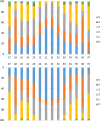Clinical changes in the severity of dental fluorosis: a longitudinal evaluation
- PMID: 34294056
- PMCID: PMC8299689
- DOI: 10.1186/s12903-021-01729-3
Clinical changes in the severity of dental fluorosis: a longitudinal evaluation
Abstract
Background: Dental fluorosis (DF) has been one of the most prevalent pediatric dental conditions associated with aesthetic concern and treatment needs. This study aimed to identify the longitudinal clinical change in the severity of DF in 8-12-year-old children and its association with gender, age, severity, and tooth type.
Methods: This observational study assessed the dental aspects of the 92 Colombian children in 2015 (mean age at beginning 9.71 years ± 1.23) and 2018 (mean age 13.69 years ± 1.41), from an area with high DF prevalence. DF was recorded in all permanent teeth by two calibrated examiners using the Thylstrup and Fejerskov Index (TFI). DF severity change (maximum-TFI-score) was analyzed with descriptive analysis at the tooth level. Associated factors were evaluated with the generalized linear model, binomial family, and logarithmic link function.
Results: TFI scores ranged between 1 (very mild) to 6 (severe), being score 2 (41.7%) the most prevalent. After three years, 29.6% of the teeth presented score reduction, 24.1%, increased and 46.3% did not change; the significant association was related to increasing of the basal TFI = 1 score (44.2%) (RR = 9.7; 95% CI 1.7-56.5; p = 0.01) and with canines, premolars and second-permanent-molars teeth group (RR = 3.3; 95% CI 1.9-5.6; p = 0.005).
Conclusion: The present study based on clinical features about DF confirms the dynamic post-eruptive nature of this condition. After three years of follow-up, a considerable proportion of the teeth changed to a higher score. Furthermore, the canines, premolars, and second-permanent-molars showed a higher incidence of an increase in severity of TFI score.
Keywords: Dental fluorosis; Longitudinal; Permanent dentition; Severity.
© 2021. The Author(s).
Conflict of interest statement
The authors declare no conflict of interest.
Figures
References
Publication types
MeSH terms
LinkOut - more resources
Full Text Sources
Miscellaneous




